Tony Alves attended the Association for Learned and Professional Society Publishers 2023 Annual Conference in Manchester, UK. Among the many interesting topics covered, Alves chose to focus this three-part blog series on three sessions that he felt reflected some of the big concerns facing scholarly publishers today, fairer metrics, technological disruption, and Chinese research priorities. In this second blog post, Alves presents two differing opinions on China’s interest in open science and open access.
How Committed is China to Open Access and Open Science?
Tony Alves, SVP of Product Management, HighWire Press
The session on “Open Access in China: Positioning publishers to succeed in the world’s largest market for articles” presented two somewhat differing takes on the acceptance and opportunities of open access (OA) in China. Nicko Goncharoff, Managing Director at Osmanthus Consulting presented a tentative viewpoint, and discussed data that showed a slowing OA uptake and a defensive attitude, while Lei Shi, Deputy Editor-in-Chief for the Tsinghua University Press, presented a more growth-oriented, outward looking picture of OA in China.
Goncharoff pointed out that even though China has been a significant driver of OA, only 35% of their annual article output is OA, while the rest of the world has an OA output of 44%. The headwinds against OA in China are the ambiguity around OA quality, the lack of good data around OA, and concerns with article processing charges (APCs).
Goncharoff states that there is no consistent or national approach to OA and many Chinese researchers still associate OA with predatory publishing. The Chinese government funds much of the research, which means that the publications are often free, which means that many articles are not classified as OA, even though they can be considered Diamond OA.
The bigger concern is around APCs and the affordability and sustainability of having to fund such a vast volume of articles. Goncharoff lays out the cost concerns. Between 2012 and 2021, China published 1.1 million OA articles. Using an average APC cost of $1700, the cost to authors and their institutions is around $1.85 billion. There is now a movement to define a “Reasonable APC”. It is suggested that a reasonable APC is $1200, significantly lower than the APCs of many of the most prestigious international journals. In fact, the Chinese Academy of Science (CAS) has now set the APC for their National Sciences Open journal at $1200. This means that publishers outside of China will likely see increased pressure to lower their APCs.
The revenue opportunity that APCs represent is pushing China to look for ways to capture some of that spend, rather than send the money abroad. One such initiative is the China Journal Excellence Action Plan (CJEAP). The CJEAP is a five-year project to create over 400 world-class, Chinese owned STM journals. The goal is to not only capture OA money, it is also to keep some of the research, currently published internationally, inside China.
Recognizing the APC cost challenges, and acknowledging that Chinese interests lie with keeping revenue and science inside China, Shi presented statistics that countered Goncharoff’s contention that OA was slowing in China. In fact, Shi insists that the open science movement in China is growing and accelerating, which means that OA is also growing. From 2011 to 2021, the number of open access papers published by Chinese researchers had increased from approximately 25,000 to over 238,000. In a survey, conducted in June and July 2022 by the China Association for Science and Technology, almost 60% of Chinese researchers understood the value of open access. The survey also showed that “expanding global recognition of their research” was the number one reason for seeking open access, with “accelerating the dissemination of research results” a close second. Other advantages included “faster publication” and a belief that “OA will generate higher citation counts”.
Shi traced the path of the open science movement in China, starting with the launch of SciencePaper Online in 2003, the first open access repository and full-text preprints platforms in China, followed by the signing of the Berlin Declaration in 2004. Other significant OA initiatives include the launch of China Open Access Journals (COAJ) in 2010, the launch of the preprint platform ChinaXiv in 2016, the launch of the National Open Platform for STM Journals in 2020, and the National law of Science and Technology Promotion in 2021, which required the development of open science.
As deputy editor-in-chief for the Tsinghua University Press (TUP), Shi used Tsinghua’s open science policies as an example of China’s embrace of OA. Open Science is a core value of the university, and an open infrastructure has been developed called SciOpen. This resource for discovering open access scientific and technical content also provides publishing services to TUP and its publishing partners. The services include submission and peer review, editorial and production services, content hosting, identity management and analytics.
Shi concluded by listing the efforts required to embrace open science, such as training authors, reviewers and editors, strengthening scientific research ethics, cooperating with international partners, and contributing to making research data findable, accessible, interoperable and reusable (FAIR). It is clear that open science and open access are a force in China, the question is how much of a force.



